
Star Trek: The Next Generation (TNG) is an American science fiction television series created by Gene Roddenberry. It originally aired from September 28, 1987, to May 23, 1994, in syndication, spanning 178 episodes over seven seasons. The third series in the Star Trek franchise, it was inspired by Star Trek: The Original Series. Set in the latter third of the 24th century, when Earth is part of the United Federation of Planets, it follows the adventures of a Starfleet starship, the USS Enterprise (NCC-1701-D), in its exploration of the Alpha quadrant and Beta quadrant in the Milky Way galaxy.
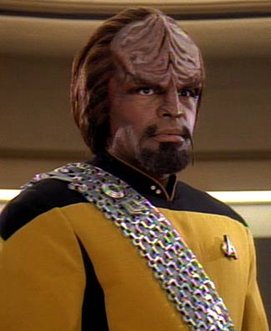
Worf, son of Mogh is a fictional character in the Star Trek franchise, portrayed by actor Michael Dorn. He appears in the television series Star Trek: The Next Generation (TNG), seasons four through seven of Star Trek: Deep Space Nine (DS9), and the third and final season of Star Trek: Picard, as well as the feature films Star Trek Generations (1994), Star Trek: First Contact (1996), Star Trek: Insurrection (1998), and Star Trek: Nemesis (2002).

The Romulans are an extraterrestrial race in the American science fiction franchise Star Trek. Their adopted home world is Romulus, and within the same star system they have settled a sister planet Remus. Their original home world, Vulcan, was renamed Ni'Var later in canon. They first appeared in the series Star Trek (1966–1969). They have appeared in most subsequent Star Trek releases, including The Animated Series, The Next Generation, Deep Space Nine, Voyager, Enterprise, Discovery, Picard, Strange New Worlds, and Lower Decks. They appear in the Star Trek feature films Star Trek V: The Final Frontier (1989), Star Trek VI: The Undiscovered Country (1991), Star Trek: Nemesis (2002) and Star Trek (2009). They also appear in various other spin-off media, including books, comics, toys and games.
Enterprise or USS Enterprise, often referred to as the Starship Enterprise, is the name of several fictional spacecraft, some of which are the main craft and setting for various television series and films in the Star Trek science fiction franchise. The most notable were Captain James T. Kirk's USS Enterprise (NCC-1701) from the original 1960s television series, and Captain Jean-Luc Picard's USS Enterprise (NCC-1701-D) from Star Trek: The Next Generation.
The Star Trek fictional universe contains a variety of weapons, ranging from missiles to melee. The Star Trek franchise consists mainly of several multi-season television shows and a dozen movies, as well as various video games and inspired merchandise. Many aspects of the Star Trek universe impact modern popular culture, especially its fictitious terminology and the concept of weaponry on spacecraft. The franchise has had a widespread influence on its audiences from the late 20th to early 21st century. Notably, Star Trek's science fiction concepts have been studied by real scientists; NASA described it in relation to the real world as "entertaining combination of real science, imaginary science gathered from lots of earlier stories, and stuff the writers make up week-by-week to give each new episode novelty." For example, NASA noted that the Star Trek "phasers" were a fictional extrapolation of real-life lasers, and compared them to real-life microwave based weapons that have a stunning effect.
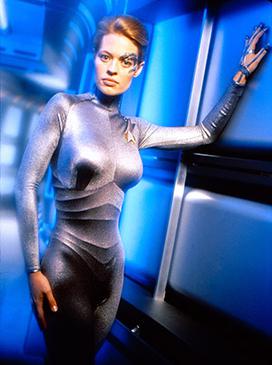
Seven of Nine is a fictional character introduced in the American science fiction television series Star Trek: Voyager. Portrayed by Jeri Ryan, she is a former Borg drone who joins the crew of the Federation starship Voyager. Her full Borg designation was Seven of Nine, Tertiary Adjunct of Unimatrix Zero One. While her birth name became known to her crewmates, after joining the Voyager crew she chose to continue to be called Seven of Nine, though she allowed "Seven" to be used informally.
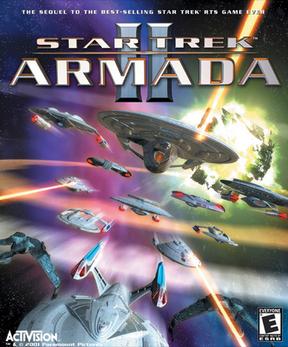
Star Trek: Armada II is a real-time strategy video game published by Activision in 2001, based upon the Star Trek universe. The game was developed by Mad Doc Software. It is the sequel to Star Trek: Armada. Star Trek: Armada II was released by Activision a year after they acquired the full rights to all the franchise holding of the video game's franchise from Viacom. It was the first of the three major Star Trek video game sequel titles that were released by Activision from 2001 until their departure from the franchise in 2003. On December 13, 2021, both Armada and Armada II were re-released on GoG.com, which had also released several other older Star Trek titles earlier that year.
"Redemption" is a two-part episode of the American science fiction television series Star Trek: The Next Generation. Parts I and II of "Redemption" comprise the 100th and 101st episodes of the series, also being the fourth season finale and the fifth season premiere.

"The Neutral Zone" is the season finale of the first season of the American science fiction television series Star Trek: The Next Generation, originally aired within the United States on May 16, 1988, in broadcast syndication. The episode originated as a story submission purchased by Paramount written by Deborah McIntyre and Mona Clee, and was turned into a teleplay by Maurice Hurley. Because of the 1988 Writers Guild of America strike, Hurley created the script in a day and a half, and the timescale forced the abandonment of both the idea of a two-part episode and of the first appearance of the Borg, which was delayed until the following season episode "Q Who".
This article discusses the fictional timeline of the Star Trek franchise. The franchise is primarily set in the future, ranging from the mid-22nd century to the late 24th century, with the third season of Star Trek: Discovery jumping forward to the 32nd century. However the franchise has also outlined a fictional future history of Earth prior to this, and, primarily through time travel plots, explored both past and further-future settings.
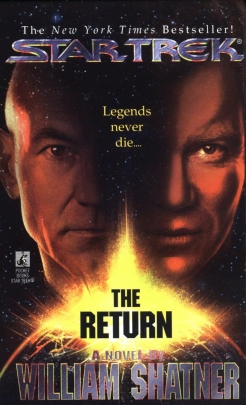
The Return is a novel by William Shatner that was co-written with Garfield Reeves-Stevens and Judith Reeves-Stevens. It is set in the Star Trek universe but, as part of the "Shatnerverse," does not follow the timeline established by other Star Trek novels. The book's sequel is Avenger.
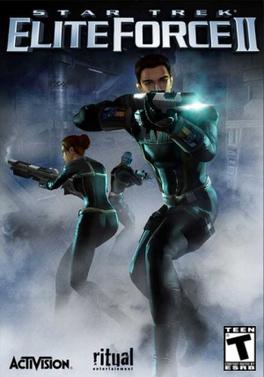
Star Trek: Elite Force II is a first-person shooter video game developed by Ritual Entertainment and published by Activision. It was released on June 20, 2003 for Microsoft Windows and later for Mac OS X. Elite Force II is a sequel to 2000's Star Trek: Voyager – Elite Force. Whereas the original game was powered by the first version of id Software's id Tech 3 engine, Elite Force II is based on a heavily modified version of the Quake III: Team Arena engine with Ritual's ÜberTools GDK, allowing for expansive outdoor environments and higher quality facial animations.
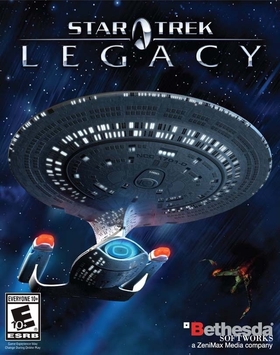
Star Trek: Legacy is a 2006 real-time tactics space combat video game for Microsoft Windows and Xbox 360 developed by Mad Doc Software and published by Bethesda Softworks in association with CBS Paramount Television and CBS Consumer Products. Originally slated for release in the fall of 2006 to coincide with the 40th anniversary of Star Trek, the Windows version was not released in North America until December 5, 2006, and the Xbox 360 version until December 15. In Europe, both the PC version and the Xbox 360 version were released on December 22, 2006.

Star Trek: New Worlds is a strategy game published in 2000 by Interplay in which the player can choose to command the forces of the United Federation of Planets, Klingons or Romulans. The player's goal is to build successful colonies on a series of newly discovered planets while battling off competing factions.

Star Trek: Encounters is a video game set in the Star Trek fictional universe, which was released in 2006 for the PlayStation 2. The game was developed by Scottish studio 4J Studios for Bethesda Softworks and Ubisoft (EU).

Jean-Luc Picard is a fictional character in the Star Trek franchise, most often seen as the commanding officer of the Federation starship USS Enterprise (NCC-1701-D). Played by Patrick Stewart, Picard has appeared in the television series Star Trek: The Next Generation (TNG) and the premiere episode of Star Trek: Deep Space Nine, as well as the feature films Star Trek Generations (1994), Star Trek: First Contact (1996), Star Trek: Insurrection (1998), and Star Trek: Nemesis (2002). He is also featured as the central character in the show Star Trek: Picard (2020–2023).
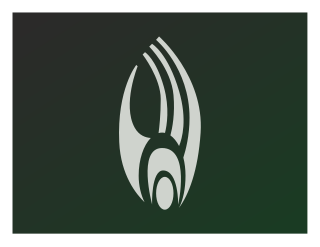
The Borg are an alien group that appear as recurring antagonists in the Star Trek fictional universe. The Borg are cybernetic organisms (cyborgs) linked in a hive mind called "The Collective". The Borg co-opt the technology and knowledge of other alien species to the Collective through the process of "assimilation": forcibly transforming individual beings into "drones" by injecting nanoprobes into their bodies and surgically augmenting them with cybernetic components. The Borg's ultimate goal is "achieving perfection".

Star Trek: Countdown is a four-issue comic book prequel to the 2009 film Star Trek by IDW Publishing. It follows the characters of Spock and the Romulan Nero during the year 2387, detailing the events that cause them to travel to the 23rd century. The story serves as both a lead up to the film, and as a continuation of the Star Trek: The Next Generation franchise.
The following outline is provided as an overview of and topical guide to Star Trek:













